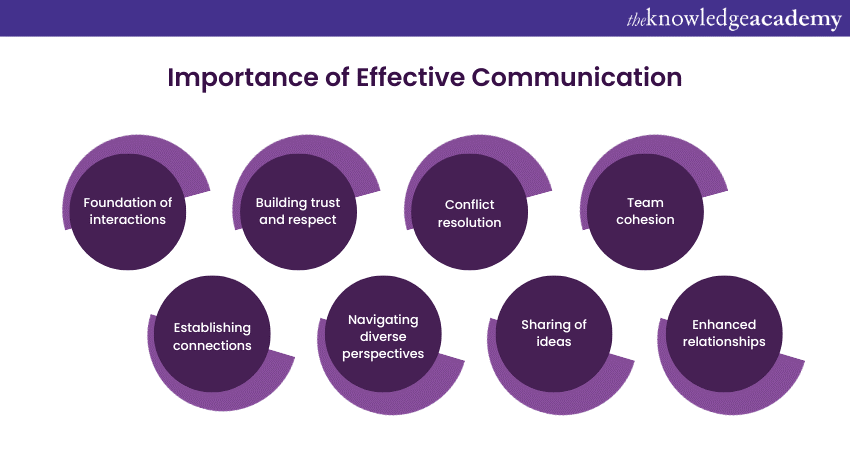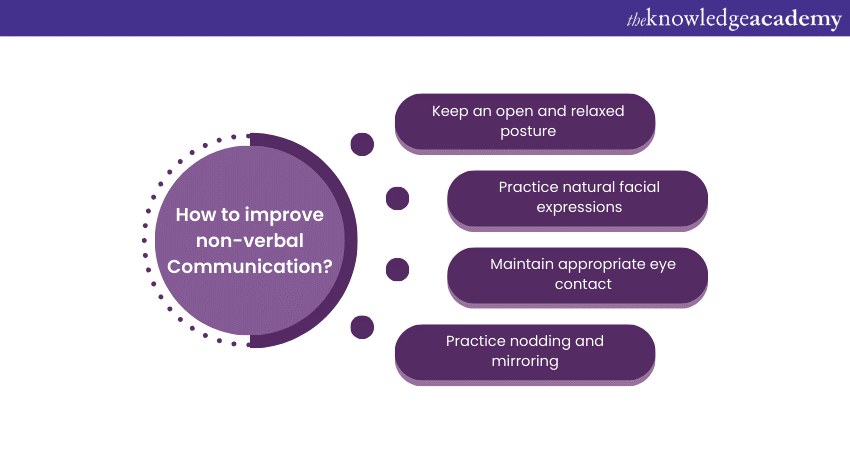At its core, Effective Communication hinges on mutual understanding, a shared comprehension between individuals that transcends mere words. It’s about fostering a connection, a common ground where ideas, thoughts, and feelings are exchanged seamlessly. In this space, the meaning behind every message is explored, discovered, and appreciated, contributing to richer, more fulfilling interactions.
Why is Effective Communication important?
Understanding the importance of Effective Communication reveals that it serves as the bedrock of our daily interactions.

1) Foundation of interactions: Effective Communication is the foundational element of all our interactions, serving as the bedrock upon which we build relationships, both personal and professional.
2) Building trust and respect: It plays a crucial role in fostering an environment of mutual trust and respect, essential components for any successful relationship.
3) Conflict resolution: Effective Communication is indispensable in resolving conflicts, helping parties involved understand differing perspectives and find common ground.
4) Team cohesion: In professional settings, it is vital to construct cohesive and collaborative teams, thereby contributing to a more harmonious and productive workplace.
5) Establishing connections: The ability to communicate effectively facilitates the establishment of fruitful and enduring connections, forming the basis of strong, resilient relationships.
6) Navigating diverse perspectives: It acts as a bridge, connecting diverse thoughts, emotions, and viewpoints, ensuring that messages are not just transmitted but are truly understood and valued.
7) Sharing of ideas: Effective Communication encourages the free sharing of ideas and the establishment of a common ground, fostering an environment where mutual respect and understanding can flourish.
8) Enhanced relationships: Recognising and harnessing the power of Effective Communication is essential for anyone seeking to navigate the complexities of Interpersonal Communication and establish meaningful relationships
Recognising and harnessing the power of Effective Communication is essential for anyone seeking to navigate the complexities of interpersonal relationships and establish meaningful connections.
The seven C’s of Effective Communication
A great way to summarise the important factors of Effective Communication is with the seven C’s. The seven C’s of Effective Communication are as follows:
1) Concise: Keeping it short and simple for easy comprehension.
2) Clear: The message conveyed should be understood clearly. Simplicity of language can help avoid misinterpretation of the message.
3) Concrete: A sign of good communication is that it is actionable. Try to provide an actionable solution or a plan of action for your intended message.
4) Correct: Make sure the message you intend to convey is correct and avoid having factual or grammatical errors.
5) Complete: For the communication to be effective, it must be delivered completely. Make sure you convey the message you intend to completely, and do not spare the details.
6) Coherent: The message you convey should always be backed up by logic and conveyed in a resonable order for your reasonable order for your listener or reader to understand.
7) Considerate: When the message is delivered politely and respectfully the receiver is more likely to receive it well and be more reciprocative.
Key principles of Effective Communication
The key Principles of Effective Communication encompass clarity, active listening, and acknowledging non-verbal cues, forming the foundation for mutual understanding and successful interaction. These principles guide the way we convey and interpret messages, ensuring that our communications are clear, meaningful, and effective.
Clarity and conciseness
At the heart of Effective Communication lies the principle of conveying messages with clarity and conciseness.
1) Simple language: Employing straightforward and accessible language is critical. This practice eliminates ambiguity, creating an environment where messages are easily understood and interpreted by the audience.
2) Avoiding jargon: When communicating with a diverse group, it becomes essential to either simplify or thoroughly explain any industry-specific terms, promoting a sense of inclusivity and comprehension among all participants.
3) Straight to the point: Bypassing lengthy and unnecessary explanations helps maintain the integrity of the core message, thus reducing the risk of misunderstandings and sustaining the audience’s interest.
Adherence to clarity and conciseness eliminates ambiguity, thereby fostering an environment of understanding and mutual respect. It lays the groundwork for the receiver to interpret the message as intended, paving the way for productive conversations.
Listening actively
Listening actively is a multifaceted aspect of communication, requiring more than just hearing the spoken words.
1) Full concentration: Offering undivided attention and focusing entirely on the speaker can significantly enhance the interaction, leading to a more profound connection and understanding.
2) Understanding and responding: This involves not only acknowledging the spoken words but also interpreting the emotions and intentions behind them, followed by a thoughtful and relevant response.
3) Remembering: The ability to remember and refer back to previously discussed points showcases a level of engagement and respect that can deepen the relationship between the communicators.
By embracing active listening, we cultivate mutual understanding and respect, creating a dialogue that is as much about receiving as it is about transmitting information.
Non-verbal communication
Non-verbal elements in communication often convey more information and insight than the actual spoken words.

1) Body language: The importance of body language, including posture and gestures, is paramount. These non-verbal cues can either support or contradict the spoken message, hence the need for awareness and control.
2) Eye contact: Maintaining appropriate eye contact signals interest and engagement, fostering a sense of trust and openness in the conversation.
3) Facial expressions: Expressions like smiling, frowning, or raised eyebrows communicate a wide range of emotions, providing additional context to the spoken words.
Acknowledging the impact of non-verbal cues is essential, as they convey volumes about our intentions and feelings. Being aware of and proficient in non-verbal communication enhances our ability to communicate effectively, ensuring our messages are comprehended in their entirety.
Master the unspoken language with our Nonverbal Communication Training – Sign up today!
Strategies to enhance Effective Communication
Now, let’s talk about the methodologies that can be employed to elevate the way we interact, focusing on fostering empathy, establishing robust feedback mechanisms, and adeptly adjusting communication styles to align with diverse audience needs and expectations. These strategies are integral for forging deeper connections, fostering mutual understanding, and ensuring messages are conveyed effectively.
Empathy and understanding
Harnessing empathy and understanding in communication is instrumental in recognising and valuing diverse perspectives, thereby creating a foundation of trust and rapport.
1) Acknowledging perspectives: Actively acknowledging and valuing others’ viewpoints builds a landscape of inclusivity and mutual respect, vital for meaningful interactions.
2) Attentiveness to emotions: Probing beneath the surface to understand emotional undertones enhances responsiveness and fosters deeper connections.
3) Building rapport: The cultivation of understanding and empathy nurtures a harmonious relationship, laying the groundwork for trust and fruitful collaboration.
By emphasising empathy, we build rapport and trust, fostering an environment where different perspectives are valued and respected. This strategy lays the foundation for meaningful and enriched interactions.
Discover the art of influential Communication for a brighter future with our Communication Skills Training – Sign up now!
Feedback mechanism
The incorporation of a robust feedback mechanism is essential in confirming the accurate reception of messages and swiftly addressing any discrepancies or misunderstandings that may arise.
1) Verifying understanding: Regular confirmation that the communicated message is accurately understood is imperative, safeguarding against misunderstandings and ensuring clarity.
2) Addressing issues promptly: A well-structured feedback loop facilitates immediate resolution of issues, smoothing the communication pathway and enhancing mutual understanding.
3) Enhancing communication: Consistent feedback serves as a tool for refining communication strategies, optimising the communicative experience for both sender and receiver.
Implementing a solid feedback mechanism guarantees that both sender and receiver are on the same page, enhancing the overall effectiveness of communication and reducing the scope for errors.
Adjusting communication style
Consciously adjusting your communication style to resonate with the audience's unique preferences, expectations, and cultural context is a cornerstone of Effective Communication.
1) Awareness of preferences: Discerning and adapting to the audience’s communicative preferences ensures the message is well-received and impactful.
2) Adapting to expectations: Aligning communication with the audience’s expectations heightens message relevance and strengthens communicative bonds.
3) Cultural nuances: Acknowledging diverse cultural expressions and sensitivities enriches the interaction, establishing a foundation of mutual respect and shared understanding.
Being flexible and adjusting your communication style ensures that your message resonates with the audience, paving the way for mutual understanding and respect. It’s a step towards making every interaction more impactful and meaningful.




